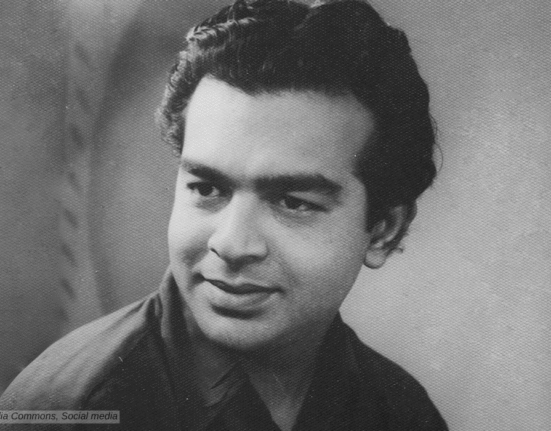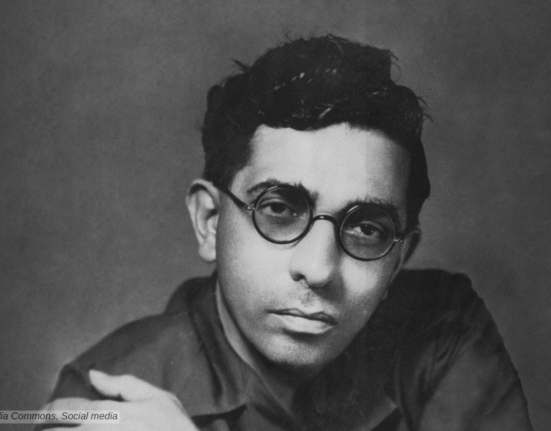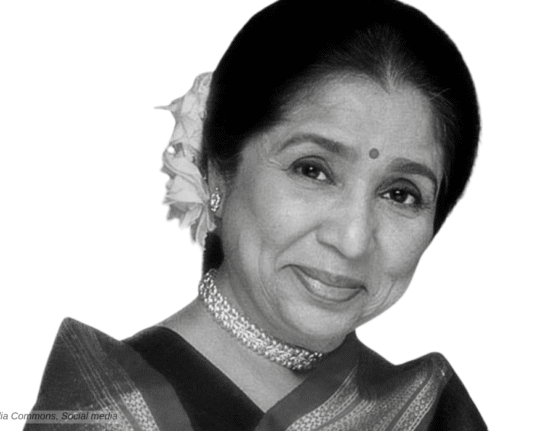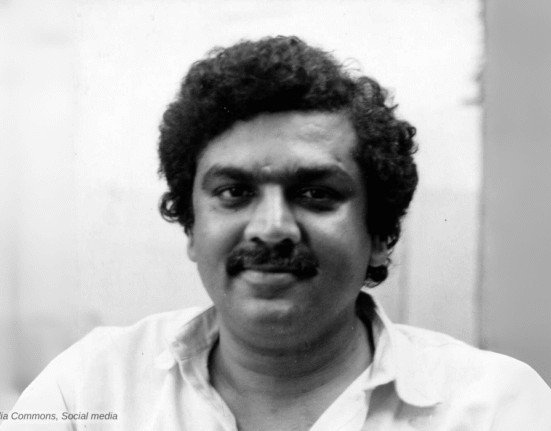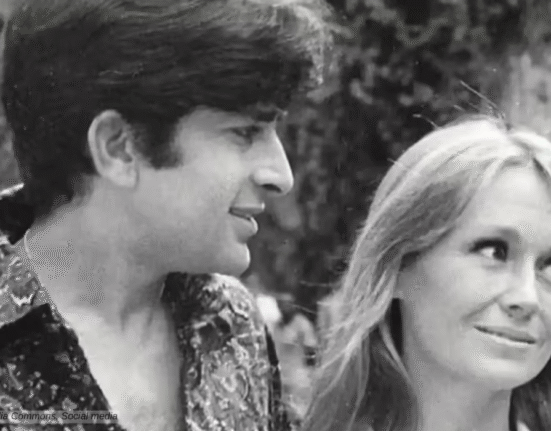Perhaps the most beloved personalities ever to grace the cinema, Mohammed Rafi remains a monumental figure in Indian music, celebrated for his versatility as a playback singer. His voice shaped Hindi cinema’s golden era, spanning nearly four decades.
The man with “single expression” and many voices…! Salute to his “Smile” and the “Golden Voice”…!
Early Life and Musical Training
Mohammed Rafi was born on December 24, 1924, in Kotla Sultan Singh, a village near Amritsar, Punjab. He belonged to a Punjabi Jat Muslim family. His father, Haji Ali Mohammed, ran a men’s barbershop, and his mother, Allah Rakhi was a homemaker. Rafi was the second eldest of six brothers: Mohammed Safi, Mohammed Deen, Mohammed Ismail, Mohammed Ibrahim, and Mohammed Siddique. The family moved to Lahore in 1935 for better opportunities. As a child, Rafi, nicknamed Pheeko, imitated the chants of a wandering fakir in his village, sparking his love for music. His brother-in-law, Mohammed Hameed, recognized his talent and encouraged his musical pursuits.
Rafi’s formal education was limited. He attended a local school in Kotla Sultan Singh but showed little interest in academics. After the family’s move to Lahore, he worked at his brother’s barbershop while pursuing music.
Education and Musical Training
Rafi trained in Hindustani classical music under renowned maestros. His early eaducation came under Ustad Abdul Wahid Khan of the Kirana Gharana. Ustad taught him the basics of classical music and intricacies of raags. Pandit Jiwan Lal Mattoo introduced him to Punjabi folk ragas like Pahaadi and Bhairavi. Ustad Bade Ghulam Ali Khan of the Patiala Gharana and Firoze Nizami, a producer at All India Radio Lahore, further honed his skills. Rafi’s early influences included singers K.L. Saigal and G.M. Durrani, whose styles he initially emulated.
Rafi’s first public performance came at 13 in Lahore, during a K.L. Saigal concert disrupted by a power outage. His brother Hamid convinced the organizers to let Rafi sing until power returned. Composer Shyam Sunder, present in the audience, gave him his first break. In 1941, Rafi debuted as a playback singer in the Punjabi film Gul Baloch (released in 1944) with the duet “Soniye Nee, Heeriye Nee” alongside Zeenat Begum, under Shyam Sunder’s direction. He also sang for All India Radio Lahore that year.
Mohammed Rafi moved to Bombay in 1944, living in a small rented room in Bhendi Bazar with with his brother-in-law, Mohammed Hameed. Rafi’s association with Naushad began in 1944 when Rafi was just starting his career in the Hindi film industry. Naushad, already an established music director, recognized Rafi’s potential and provided him with the opportunity to sing in the film “Pehle Aap” in 1944, where he featured in three songs “Tum Dilli Main Aagre,” “Ek Baar Unhein Mila De,” and “Hindustan Ke Hum Hain Hindustan Humara.”
Mohammed Rafi In Bombay
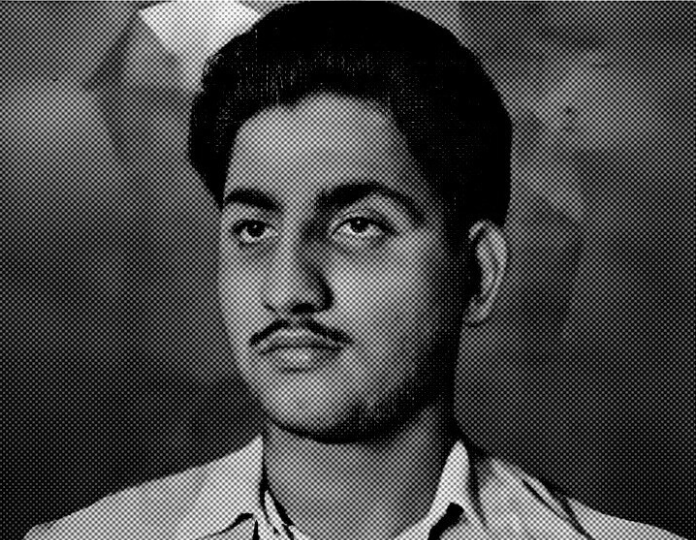
In 1945, he appeared onscreen in Laila Majnu, singing “Tera Jalwa Jis Ne Dekha,” with chorus singers, under Pandit Govindram’s music direction.
However, it was the film “Anmol Ghadi” (1946) that truly marked the beginning of their professional relationship, with Rafi singing “Tera Khilauna Toota Baalak,” under Naushad’s baton.
In Jugnu (1947), Rafi sang “Yahan Badla Wafa Ka Bewafai Ke Siwa Kya Hai,” a duet with Noor Jehan, under Firoze Nizami’s direction. This melancholic track, picturized on Dilip Kumar and Noor Jehan, became a major hit. It highlighted Rafi’s ability to convey deep emotion, a skill that defined his later work.
The 1947 partition posed a significant challenge for Rafi. He chose to stay in India while some family members stayed in their ancestral place which was in Pakistan. His wife who lost both his parants in the riots decided not to come to Bombay, and they separated. With a broken heart Rafi started his life again.
In 1948, after Mahatma Gandhi’s assassination, Mohammed Rafi sang “Suno Suno Ae Duniyawalon, Bapuji Ki Amar Kahani.” The song, composed overnight by Husanlal Bhagatram, aired on All India Radio. In 1948 he sang “Ek Dil Ke Tukde Hazaar Hue,” under Husnlal Bhagatram in Pyar Ki Jeet. The same year came Shaheed which has “Watan Ki Raah Mein.”
Mohammed Rafi and Naushad
The 1950s and 1960s are often referred to as the Golden Era of Hindi cinema, and the Rafi-Naushad duo played a significant role in defining the musical landscape of that time. Naushad’s compositions, deeply rooted in Indian classical and folk music, found the perfect vocal expression through Rafi’s versatile singing. The purity of Rafi’s voice complemented Naushad’s intricate melodies, creating songs that were rich in emotion and technical excellence.

In Mela (1948), Rafi sang “Yeh Zindagi Ke Mele,” another Naushad composition, picturized on Dilip Kumar. The song’s philosophical tone about life’s fleeting nature resonated with audiences.
A. R. Kardar’s “Dulari (1948),” starring Madhubala, Suresh, and Geeta Bali, has one of the finest Rafi numbers, “Suhani Raat Dhal Chuki.” In 1951 Rafi sang “Bachpan Ke Din Bhula Na Dena,” “Hue Hum Jinke Liye Barbaad,” and “Meri Kahani Bhoolne Wale” in “Deedar.”
In Mehboob Khan’s “Aan (1952),” he sang songs like “Maan Mera Ehsan, Arrey Nadaan,” “Dil Mein Chhupa Ke Pyar Ka Toofan.”
Rafi Sang For Naushad
Then comes “Baiju Bawra (1952),” which demonstrated Naushad’s grasp of classical music and his ability to bring it to the masses. The compositions of Baiju Bawra were based on classical ragas. In the film Rafi sang gems like “Man Tarapat Hari Darshan Ko Aaj,” “O Duniya Ke Rakhwale,” “Tu Ganga Ki Mauj Mein Jamana Ka Dhara,” and “Door Koi Gaye Dhun Yeh Sunaaye.”
One of their most memorable collaboration was “Kohinoor (1960),” a film known for its classical classical compositions. Rafi sang the fan favourite “Madhuban Mein Radhika Nache Re” and “Do Sitaron Ka Zameen Par Hai Milan Aaj Ki Raat,” in the film. In “Mughal-e-Aazam (1960),” Rafi mesmerized with “Ai Muhabbat Zindabad.”
Some of his notable songs with Naushad include “Insaaf Ka Mandir Hai Yeh (Amar),” “Aaye Na Baalam Vaada Kar Ke (Shabab),” “O Door Ke Musafir,” (Uran Khatola), “Dukh Bhare Din Beete Re Bhaiya” (Mother India), “Nain Lad Jaihe To (Gunga Januma),” “Mere Mehboob Tujhe (Mere Mehboob),” “Apni Azadi ko ha,” “Mujhe Duniya walo sharabi” (Leader), “Koi Sagar Dil Ko Behlata Nahin” “Guzre Hain Aaj Ishq Mein (Dil Diya Dard Liya), “Aaj Ki Raat Mere Dil Ki,” “Balam Tere Pyar Ki Thandi Aag Mein Jalte Jalte” (Ram aur Shyam),” “Na Aadmi Ka Koi Bharosa,” “Aaj Puraani Raahon Se (Aadmi),” “Jab Dil Se Dil Takrata Hai” “Ishq Deewana, Husn Bhi Ghayal” “Mere Pairon Mein Ghunghroo” (Sunghursh), and many more.
Rafi in The 50s
Mohammed Rafi’s journey through the 1950s began with the consolidation of his position as a premier playback singer. Rafi’s versatility was unparalleled. His exceptional ability to adapt his voice to the persona of the on-screen actor made him the preferred choice for a range of leading men, from Dev Anand, Raj Kapoor, and Dilip Kumar to Ashok Kumar, Bharat Bhushan, and Pradeep Kumar. The versatility of his vocal expression allowed him to perform songs across genres, from the heartbreaking to the heartwarming, with equal finesse.
His ability to sing in various languages and dialects only added to his appeal. The 1950s stand out as a defining decade in the illustrious career of Mohammed Rafi, one of the most revered playback singers in the history of Indian cinema. This era saw Rafi’s voice become the herald of a new musical age, his songs the anthem of a nation’s soul, and his talent the benchmark for generations to come.
Rafi also worked closely with other maestros such as O.P. Nayyar, Shankar Jaikishan, S.D. Burman, Khayyam, and Ravi. Each collaboration brought out a different facet of Rafi’s musical genius, whether it was the playful romance of Nayyar’s compositions or the classical depth of Burman’s creations.
Rafi With S. D. Burman
Mohammad Rafi worked extensively with Sachin Dev Burman. Their collaboration began in 1947 with Mushi Dil’s Do Bhai, marking Rafi’s first song for Burman. The song was “Duniya Me Mere Aaj, Andhera Hi Andhera.” Burman’s compositions demanded vocal precision and emotional depth. Burman often drew from his Bengali folk roots, as seen in songs like “Hum Bekhudi Mein Tumko Pukare” from Kala Pani, adapted from his Bengali song Ghum Bhulechi. Burman’s minimalist orchestration, especially in realistic films, complemented Rafi’s expressive delivery. Their collaboration peaked with “Pyasa,” which is remembered for its enchanting score and beautiful songs by the team of SD Burman and Sahir Ludhiyanvi. In the film Rafi sang “Sar Jo Tera Chakraye,” “Ye Duniya Agar Mil Bhi Jaye,” “Ye Hanste Huye Phool,” and “Jinhen Naaz Hai Hind Par.”
Some of their most famous songs include “Aaja Panchhi Akela Hai (Nau Do Gyarah, 1957),” “Dekhi Zamane Ki Yaari (Kaagaz Ke Phool, 1959),” “Khoya Khoya Chand Khula Aasmaan (Kala Bazar, 1960),” “Deewana Mastana Hua Dil (Bambai Ka Babu, 1960),” “Jiya O Jiya (Jab Pyar Kisi Se Hota Hai, 1961),” “Nache Mon Mora Magan,” “Tere Bin Soone Nain Hamare (Meri Surat Teri Aankhen, 1963), “Tu Kahan Yeh Bata (Tere Ghar Ke Samne, 1963),” “Tere Mere Sapne,” “Din Dhal Jaaye,” “Kya Se Kya Ho Gaya” (Guide, 1965), “Aise To Na Dekho (Teen Devian, 1965),” “Gun Guna Rahe Hai Bhanvare (Aradhana, 1969),” “Mera Man Tera Pyasa (Gambler, 1971)” “Aaye Haaye Teri Bindiaya Re (Abhimaan 1973),” and many more.
Rafi and Rafi With S. D. Burman
One of Mohammad Rafi’s most fruitful partnerships came with Shankar Jaikishan. Their collaboration began with Barsaat (1949), RK Films’ debut production, where Rafi sang “Main Zindagi Mein Hardam Rota Hi Raha.” Rafi’s versatility allowed him to handle romantic, comic, and melancholic songs with ease. One of their most memorable albums was “Aarzoo,” starring Rajendra Kumar and Sadhana. The film had Rafi gems like “Aji Humse Bachkar Kahan Jaaiyega,” “Ae Phoolon Ki Rani,” “Ae Nargis-e-Mastana,” and “Chhalke Teri Ankhon Se.”
The partnership especially shines in Shammi Kapoor’s songs like “Ehsaan Tera Hoga Mujh Par,” “Yahoo! Koi Mujhe Junglee Kahe” (Junglee, 1961), “Khuli Palak Mein Jhoota Gussa (Professor, 1962),” “Lal Chhadi Maidan Khadi,” “Tumse Achha Kaun Hai (Janwar, 1965),” “Aasman Se Aaya Farishta,” “Akele Akele Kahan Ja Rahe” (An Evening in Paris, 1967), “Dil Ke Jharokhe Mein,” “Aajkal Tere Mere Pyar Ke” (Brahmachari, 1968), “Badan Pe Sitare Lapete (Prince, 1969),” and many more.
Some of their most iconic songs include “Nanhe Munne Bachche Teri Mutthi (Boot Polish, 1954),” “Ramaiya Vastavaiya Ramaiya Vastavaiya (Shree 420, 1955),” “Badi Der Bhayee (Basant Bahar, 1956),” “Teri Pyari Pyari Surat Ko (Sasural, 1961),” “Gori Zara Hans De Tu Hans De (Asli-Naqli, 1962),” “Yaad Na Jaye Beete Dinon Ki” (Dil Ek Mandir, 1963), “Yeh Mera Prem Patra (Sangam, 1964),” “Tum Kamsin Ho Nadaan Ho (Ayee Milan Ki Bela, 1964), “Baharon Phool Barsao (Suraj, 1966),” “O Mere Shah-E-Khuba,” “Aa Ja Re Aa Zara” (Love in Tokyo, 1966), and “Gar Tum Bhula Na Doge (Yakeen, 1969),” among others.
Rafi with Ravi
The partnership between Rafi and Ravi was not in anyway less iconic than their individual careers. Ravi is known for his melodious compositions, which required the soothing voice of Rafi. Their collaboration began with Vachan (1955), where Rafi sang three duets, including “Jab Liya Hath Mein Hath, Nibhana Sath.” Ravi favored Rafi for his ability to deliver ghazals, romantic and melancholic songs, with precision. Their work spanned genres, from romantic ballads to philosophical anthems.
Ravi’s compositions emphasized melody and simplicity, using minimal orchestration to highlight the singer’s voice. He tailored songs to Rafi, ensuring the full use of his emotional depths. Ravi collaborated frequently with lyricists like Shakeel Badayuni and Sahir Ludhianvi, whose poetic verses complemented Rafi’s expressive delivery. Their most iconic film was Do Badan, where Rafi sang one of Hindi cinema’s saddest songs, “Bhari Duniya Mein,” “Naseeb Mein Jiske Jo,” and “Raha Gardishon Mein.”
Below are some of their standout songs, showcasing their range and impact:”Chaudhvin Ka Chand Ho (Chaudhvin Ka Chand, 1960),” “Husnwale Tera Jawab Nahin (Gharana, 1961),” “Baar Baar Dekho (China Town, 1962),” “Ya Meri Manzil Bata Ya (Rakhi, 1962),” “Is Bhari Duniya Mein (Bharosa, 1963),” “Aaja Tujhko Pukare Mera,” “Babul Ki Duayen Leti Ja” (Neel Kamal, 1968), “Yeh Zulf Agar Khulke,” “Chhu Lene Do Nazuk Hothon Ko” (Kaajal, 1965),” “Us Mulk Ki Sarhad Ko (Ankhen, 1968),” “Yeh Parda Hata Do, Zara Mukhda Dikha Do (Ek Phool Do Mali, 1969) and many more.
Rafi with OP Nayyar
In 1956 for Naya Daur, starring biggies Dilip and Vyjayanthimala, he collaborated with OP Nayyar. In the filmhe sang a superlative chorus song (Saathi haath badhana), an infectious patriotic song “(“Ye desh hai veer jawano ka,” and the unforgettable “Uden Jab Jab Zulfen Teri,” an all-time blockbuster. He also sang “Aana hai to Aa,” a song that has been described as sheer perfection and the nostaligic “Dil Leke Daga Denge.”
Some of his notable songs the 1950s include “Devta Tum Ho Mera Sahara,” “Mohabbat Kar Lo Jee Bhar Lo,” Sun Sun Sun Sun Zalima,” “Hum Laaye Hain Toofan Se Kashti Nikaal Ke,” “Jaane Kahan Mera Jigar Gaya Ji,” “Hamein Bhi De Do Sahara,” “O Le Ke Pehla Pehla Pyar,” “Yeh Hai Bombay Meri Jaan,” “Chhun Chhun Karti Aayi Chidiya,” “Chal Ud Ja Re Panchhi,” “Zara Saamne Toh Aa O Chhaliye,” “Jawaniyan Yeh Mast Mast Bin Piye,” “Hum Bekhudi Mein Tumko Pukare Chale Gaye,” “Toote Huye Khwabon Ne,” “Ik Pardesi Mera Dil Le Gaya,” “Tu Hindu Banega Na Musalman Banega,” “Dil Deke Dekho Dil Deke Dekho,” “Hum Aur Tum Aur Ye Sama,” “Chand Sa Mukhda Kyon Sharmaya,” “Dekhi Zamane Ki Yaari Bichhde,” “Deewana Mastana Hua Dil,” “Saathi Na Koi Manzil,” “Yeh Hai Ishq Ishq,” “Zindagi Bhar Nahin Bhoolegi Woh Barsaat Ki Raat,” “Khoya Khoya Chaand Khula Aasman,” and many more.
The 60s
Mohammed Rafi’s career in the 1960s was marked by an unparalleled dominance in the playback singing industry. His voice was omnipresent, emanating from radio sets, gramophones, and cinema halls across the country. He was the voice behind the leading actors of the time; from the romantic hero Rajendra Kumar to the dynamic Shammi Kapoor, Rafi’s vocal versatility allowed him to sing for a diverse array of characters, making each song distinct and memorable.
The 1960s saw Rafi collaborate with a plethora of music directors who were redefining Indian film music. Working with legends like Shankar-Jaikishan, Madan Mohan, and Roshan, Rafi produced some of the most iconic songs of the century. His partnership with these composers resulted in a synergy that elevated the film music to new heights.
The 1960s were also the decade when Rafi became synonymous with romance. His songs captured the essence of love, longing, and heartbreak, resonating with the emotional landscape of the nation. Songs like “Teri Pyaari Pyaari Surat Ko” and “Baharon Phool Barsao” became anthems of love, etching Rafi’s voice into the collective memory of the country.
Rafi’s willingness to experiment with different genres and styles kept his music fresh and relevant. From classical masterpieces to peppy rock-and-roll numbers, Rafi’s experimental approach showcased his range and adaptability. His song “Aaja Aaja Main Hoon Pyaar Tera” from the film ‘Teesri Manzil’ is a prime example of his ability to blend traditional Indian music with modern trends.
Amidst the backdrop of post-independence India, Rafi’s patriotic songs stirred the nation’s spirit. His rendition of “Jahan Daal Daal Par” from the film ‘Sikandar-e-Azam’ (1965) became a symbol of national pride and is still revered as one of the most inspiring patriotic songs in Indian cinema.
The 70s
The 1970s saw the emergence of new musical styles and voices that transformed the Bollywood soundscape. Mohammed Rafi faced stiff competition from the rising star Kishore Kumar, who became the preferred voice for the then superstar Rajesh Khanna and the emerging Amitabh Bachchan. Despite this, Rafi’s versatility and unparalleled talent ensured that he remained a formidable presence in the industry.
Throughout the 1970s, Rafi continued to work with a variety of music directors who had been integral to his success in the previous decades. His collaborations with composers like Laxmikant-Pyarelal, Madan Mohan, Kalyanji AanadJi, and R.D. Burman resulted in a number of hit songs that are cherished to this day. Rafi’s ability to adapt to the changing musical landscape while maintaining his unique style was evident in his work during this period.
Despite the competitive environment, the 1970s produced some of Rafi’s most iconic songs. Tracks like “Kya Hua Tera Wada” from the movie ‘Hum Kisise Kum Naheen’ (1977) showcased his enduring appeal. The song not only won him the National Film Award for Best Male Playback Singer but also reaffirmed his status as a singer capable of evoking deep emotions through his music.
Awards
Throughout his career, Mohammed Rafi was honored with numerous awards. He won six Filmfare Awards, one National Film Award, and gets the prestigious Padma Shri in 1967.
His Filmfare nominated songs are “Chaudhvin Ka Chand Ho (Chaudhvin Ka Chand),” “Teri Pyaari Pyaari Surat Ko (Sasural),” “Husnwale Tera Jawab Nahin (Gharana),” “Aye Gulbadan Aye Gulbadan (Professor),” “Mere Mehboob Tujhe (Mere Mehboob),” “Chahunga Main Tujhe (Dosti),” “Chhoo Lene Do Nazuk Hothon Ko (Kaajal),” “Baharo Phool Barsao (Suraj),” “Dil Ke Jharoke Mein (Brahmachari),” “Mein Gaaon Tum Sojaao (Brahmachari),” “Badi Mastani Hai (Jeene Ki Raah),” “Khilona Jaan Kar (Khilona),” “Hum Ko To Jaan Se Pyaari (Naina),” “Achha Hi Huva Dil Toot Gaya (Maa Bahen Aur Biwi),” “Kya Hua Tera Wada (Hum Kisise Kum Naheen),” “”Parda Hai Parda (Amar Akbar Anthony),” “Aadmi Musaafir Hai (Apnapan),” “Chalo Re Doli Uthao Kahaar (Jaani Dushman),” “Mere Dost Kissa Yeh (Dostana),” “”Dard-e-dil Dard-e-jigar (Karz),” and “Maine Poocha Chand Se (Abdullah).”
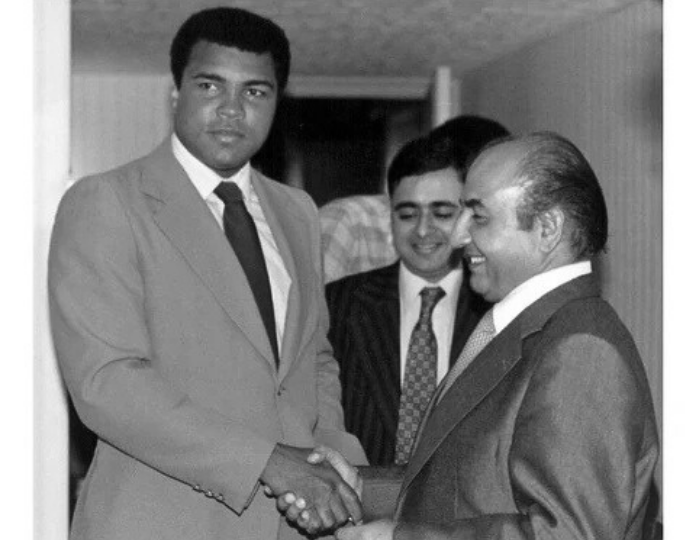

Personal Life
Mohammed Rafi married his cousin Bashira in the early 1940s. The couple faced challenges during the 1947 partition. Bashira’s parents died in the riots, prompting her to move to Lahore, Pakistan, with her family. She refused to live in India, leading to the end of their marriage.
In 1948, he married Bilquis, his second wife, in India. The couple began their family in the late 1940s. Their first child, daughter Parveen, was born in 1949. Rafi and Bilquis later had six more children: sons Saeed, Khalid, Hamid, and Shahid, and daughters Nasreen and Yasmin. Rafi remained a private family man, balancing his rising career with his responsibilities as a father and husband. His family was his support system, and he was known to be a devoted family man.
Apart from singing, Rafi had a passion for playing badminton, carom, and flying kites. These hobbies reflected his playful nature and love for simple pleasures in life. He was also known for his philanthropy and often performed at charity events, reflecting his compassionate personality.
Legacy
One of his notable controversy regarding royalty issues with fellow singer Lata Mangeshkar. However, he always maintained a dignified stance and resolved conflicts with grace. His son, Shahid Rafi, has often spoken out to protect his father’s legacy from any misrepresentation.
Even after his passing on July 31, 1980, Rafi’s legacy continues to live on. His songs have transcended time, still being celebrated and revered by music lovers around the world. Documentaries and biographies, such as ‘Mohammed Rafi – Golden Voice of the Silver Screen’ and ‘Dastaan-E-Rafi,’ have been dedicated to his life, showcasing the impact he had on the music industry.
Mohammed Rafi was not just a singer; he was an institution, an inspiration, and a voice that became the soundtrack of many lives. His contribution to Indian music is immeasurable, and his melodious journey will continue to inspire generations.
Mohammed Rafi on IMDB




